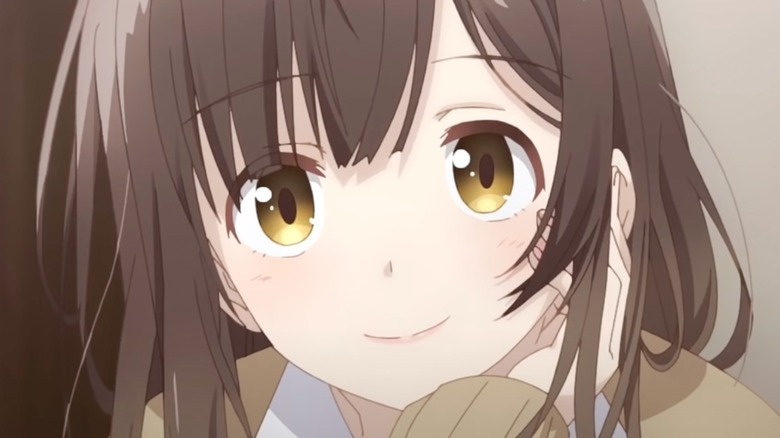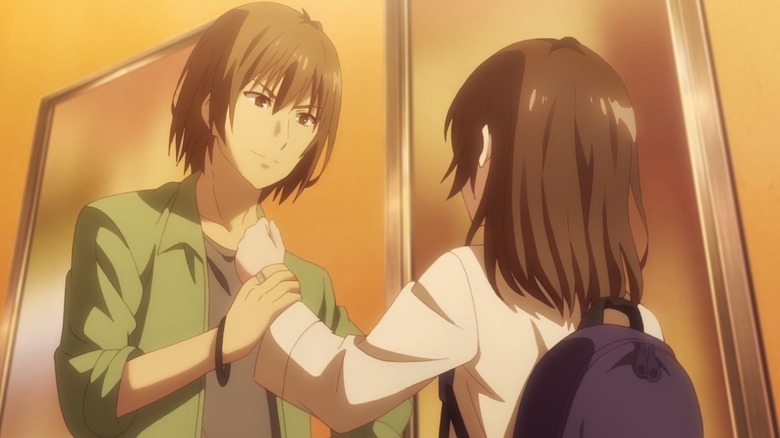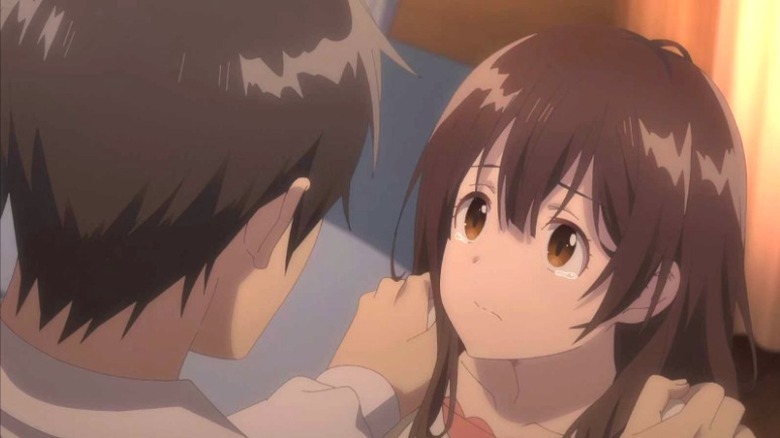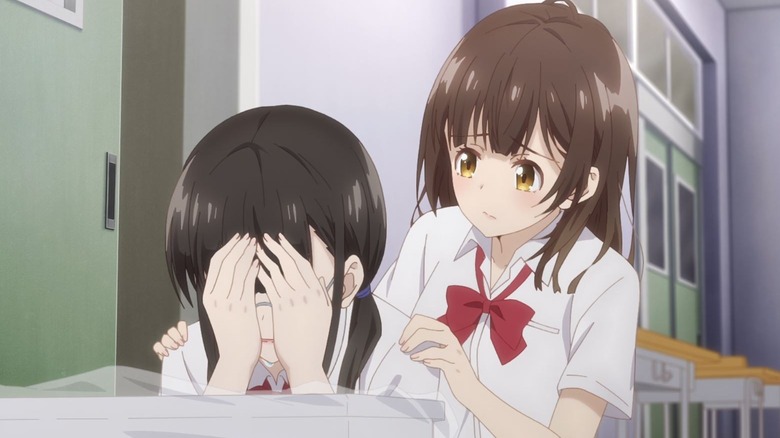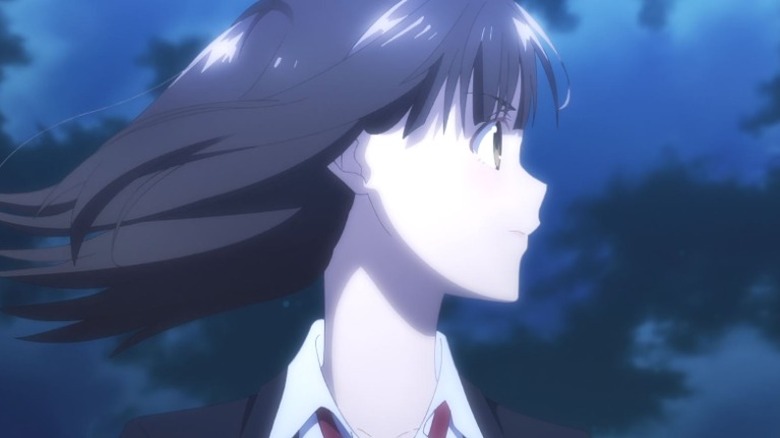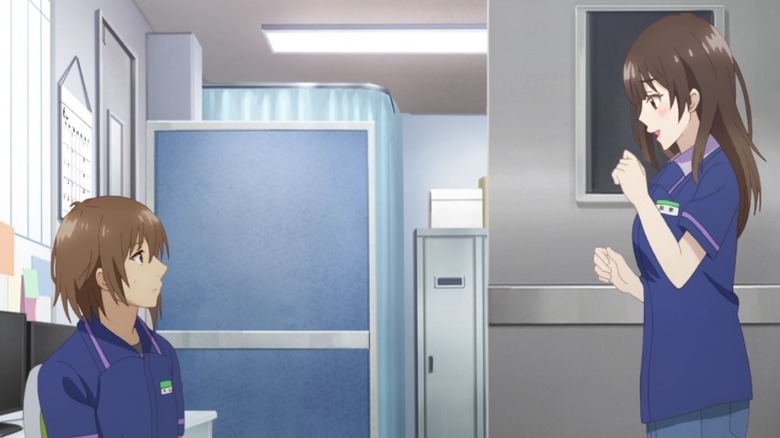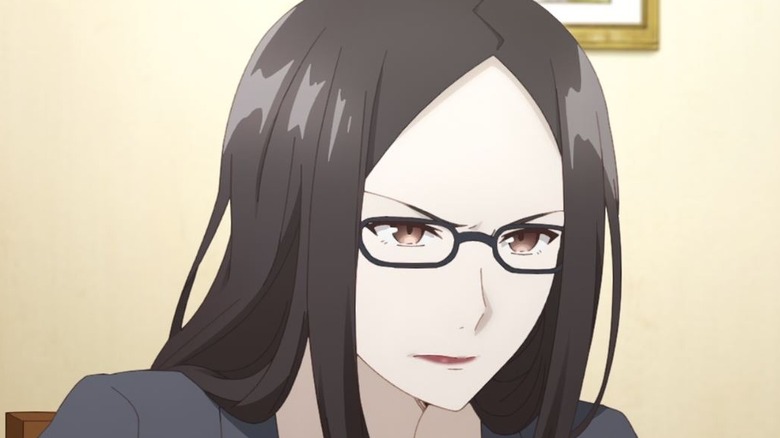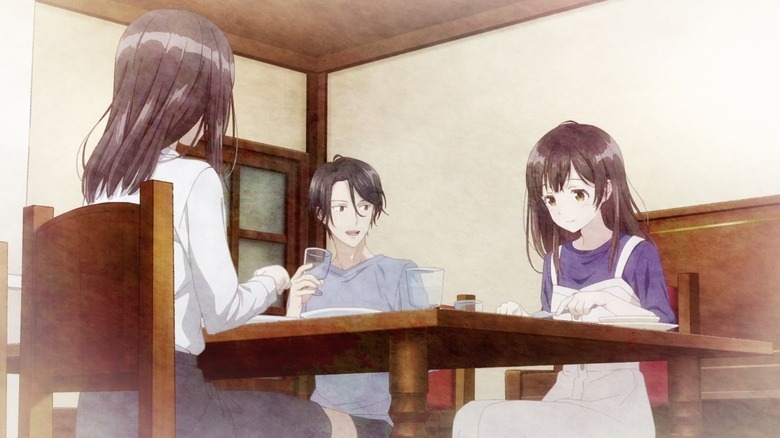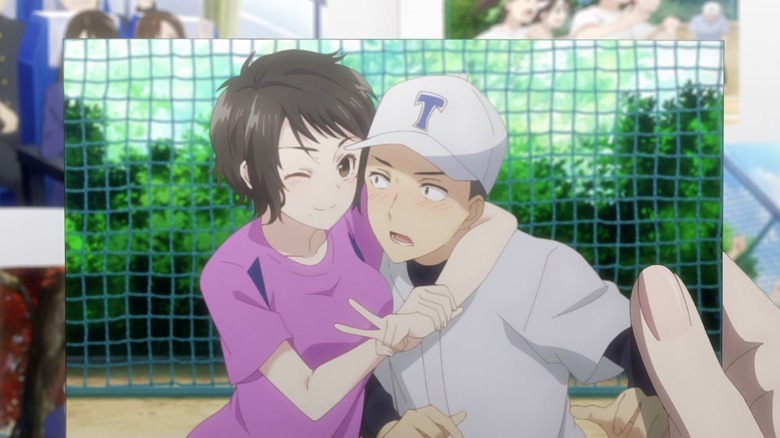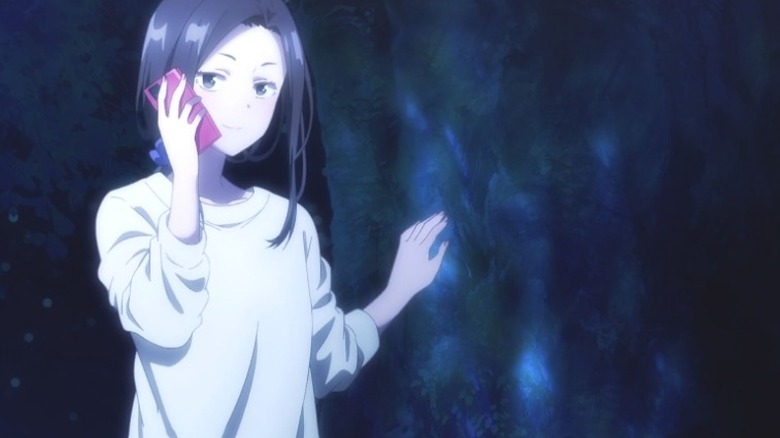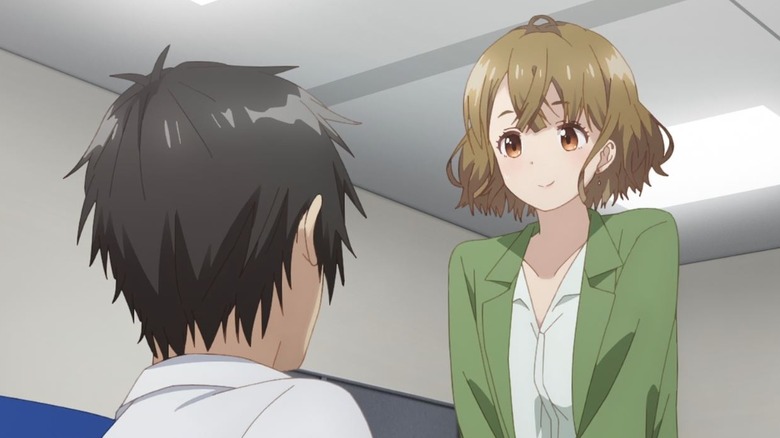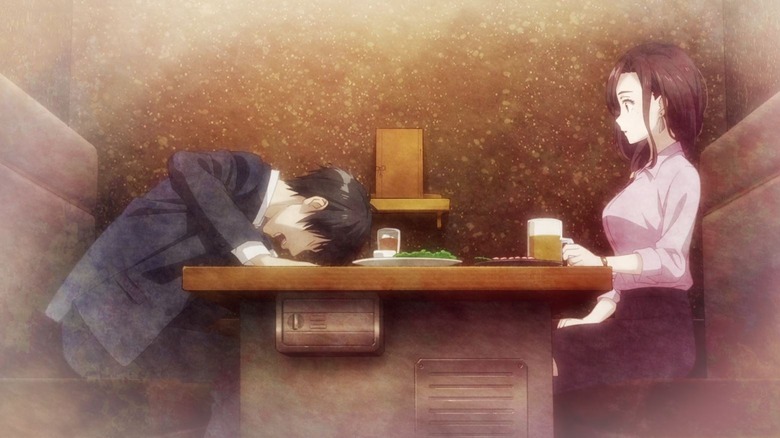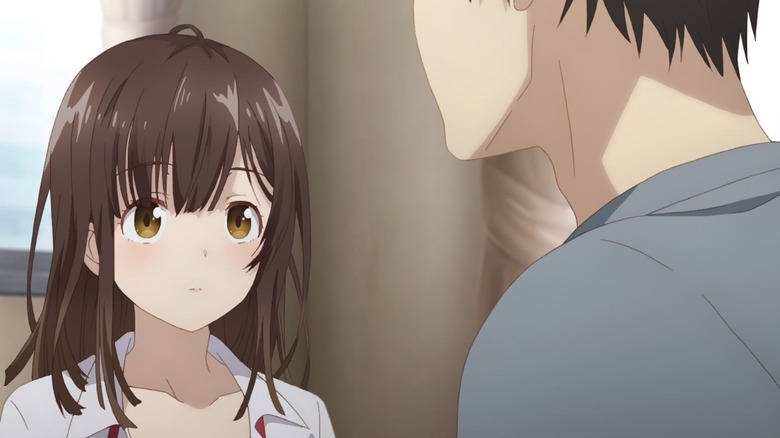The Ending Of Hige Wo Soru Season 1 Explained
"Hige wo Soru" is a complex series to analyze. It tells the story of a man who provides an abused girl with a home and helps her recover from trauma. However, while many anime series tend to confuse sexual harassment and assault with romance, as observed in a lengthy exploration of sexuality in manga and anime published by the New York Public Library, "Hige wo Soru" manages to approach the topic from a more serious perspective. It depicts the effects abuse can have on teenagers and what happens if they don't receive the support they need. Sadly, it's also a romantic comedy that sexualizes its female characters and romanticizes the relationship between an underage girl and an adult.
The series may be a step in the right direction when it comes to discussing sensitive issues like physical and psychological abuse, depression, and suicide in anime. However, it's also guilty of normalizing sexual assault, implying that returning to a psychologically abusive home is a good idea and never even suggesting the possibility that victims of abuse should seek justice or professional help. This might explain why "Higehiro," as the series is also known, has received positive reviews but is also considered highly controversial. As such, its story and conclusion demand careful and detailed analysis — here is the ending of "Hige wo Soru" explained.
If you or anyone you know has been a victim of sexual assault, help is available. Visit the Rape, Abuse & Incest National Network website or contact RAINN's National Helpline at 1-800-656-HOPE (4673).
Higehiro exemplifies how abusers manipulate people
During the first episodes of "Higehiro," Sayu obtains a place to live, friends, and even a job. However, by Episode 6, viewers quickly realize that none of this means that she is safe. In "Starry Sky," Sayu recognizes one of the men who works in the convenience store as someone who allowed her to stay at his place in exchange for sex. Kyouya Yaguchi calls their past relationship "living together," and, after her shift ends, he asks her to go to her place, stating that he just wants to talk. When Sayu rejects his plans, he explains that if she agrees, he won't tell her boss about her past. In the end, Sayu sees no other option than to accept his proposal.
The tense scene makes it clear how emotionally vulnerable Sayu is at this point, but it also illustrates different techniques abusers use in real life to manipulate their victims. As psychologist Melanie Greenberg explains in Psychology Today, predators will frequently try to normalize the situation by acting like nothing out of the extraordinary happened. They will also use different excuses to be alone with their victims, starting with a seemingly unimportant request and use threats. "Starry Sky" is not an easy watch, but it makes it clear that Sayu's emotional state is far more serious than we are led to believe — and it presents Kyouya as a textbook abuser.
If you or anyone you know has been a victim of sexual assault, help is available. Visit the Rape, Abuse & Incest National Network website or contact RAINN's National Helpline at 1-800-656-HOPE (4673).
Sayu wasn't fully aware she was a victim of abuse
From the start, Sayu is very open about her past with Yoshida. She explains to him what happened to her in a very clear and calm manner. While initially reluctant to discuss this with her boss and best friend Asami, or Yoshida's love interest Airi, Sayu eventually describes her past experiences to them using a similar tone. This may have given the impression that Sayu didn't see her experience as traumatic, but the end of Episode 6 presents a very different picture.
After a short conversation at Yoshida's apartment, Kyouya pressures Sayu into having sex. When she rejects him, he becomes violent. Sayu panics, blaming herself for letting a man like Kyouya into the apartment. It is at this point that Yoshida arrives, kicks Kyouya out of the apartment, and returns to console Sayu. Visibly moved by what just happened, Sayu expresses her disbelief at how the prospect of having sex with one of those men, something that she used to consider a normal occurrence, seems so appalling now.
Sayu is not alone in her experience. A high percentage of sexual assault victims don't realize the severity of what actually happened to them, a phenomenon known to psychologists as "unacknowledged assault," per The Guardian. Sometimes, like in the case of Sayu, the lack of sexual experience can become a factor, and victims can take a long time, maybe even years, to understand what really happened.
If you or anyone you know has been a victim of sexual assault, help is available. Visit the Rape, Abuse & Incest National Network website or contact RAINN's National Helpline at 1-800-656-HOPE (4673).
Bullying has serious psychological consequences
During most of the series, the reason Sayu escaped her house is left as a mystery, although it was implied that it had to do with a traumatic experience. She only decides to explain her motivation to Yuki and Yoshida after she decides to return home. Sayu describes how, while in high school, her only friend was a lonely girl named Masaka Yuuko. They spent a lot of time together, but Sayu soon realized her friend was being bullied by other girls from the school and that she was the cause.
Originally, the girls wanted to attack Sayu after she rejected a student one of them liked. However, after considering they might not be able to get away with bullying a popular girl, they decided to focus on the more vulnerable Yuuko. Sayu was not only unaware of the level of verbal and physical aggression Yuuko was suffering from. She also didn't know the psychological impact this had on Yuuko. Like many victims of bullying, Yuuko developed feelings of loneliness and even suicidal thoughts – a not uncommon condition in victims of bullying, according to a study published in the National Library of Medicine.
In Yuuko's case, this led to her death. But instead of being angry at the school for failing to prevent and detect the bullying or Yuuko's depression, Sayu blames herself, despite Yuuko's explicitly saying "This is not your fault." before dying.
If you or anyone you know is having suicidal thoughts, please call the National Suicide Prevention Lifeline by dialing 988 or by calling 1-800-273-TALK (8255).
Sayu is overcoming the trauma of losing Yuuko
The death of Yuuko was a traumatic experience for Sayu. She was not only there when it happened — she also spent a few moments unsuccessfully trying to stop her. Before dying, Yuuko says she felt bad for worrying Sayu to the point that she didn't smile anymore. Even though Yuuko makes it clear that she doesn't blame Sayu for what happened, it's evident that the fact Sayu was not able to stop her friend's suicide had a devastating effect on her.
Months later, Sayu returns to the last place she saw Yuuko alive, the roof of their high school. Even though Yoshida accompanies her, Sayu struggles to find the strength to go up the stairs, and once they make it onto the roof her PTSD symptoms become evident. During her first steps, the camera shifts into a vertigo-inducing angle while her hands start shaking, suggesting she's being overwhelmed by fear.
She also relives Yuuko's death the moment she sees the bench where they used to hang out and when she sees the fences that now prevent future suicide attempts. She starts crying, expressing her feelings of guilt for Yuuko's death while Yoshida reminds her that Yuuko would have wanted her to smile again. After a few minutes, Sayu calms down. She is now able to sit on the bench where she met Yuuko without reliving her trauma. She admits that she hasn't recovered yet, but thinks she will eventually.
None of Sayu's abusers faced consequences
"Higehiro" is very clear about the legality of Yoshida's actions. The series may paint him as a heroic figure that rescues a teenager from abuse, but characters are always reminding him that he can't host an underage girl without her parents' permission. Ironically, despite the threat of legal problems always looming over Yoshida, the possibility of Sayu's abusers facing prison is never discussed.
Throughout the series, Sayu tells her story to Yoshida, Yuki, and even Airi, but she's never encouraged to seek professional help from a therapist or make a police report. While an argument could be made that she was afraid of the police questioning Yoshida, this is less of an issue once she goes back to live with her mother.
The series also treats the only identified abuser, Kyouya, quite lightly. He is confronted by Yoshida and slapped by Yuki for his actions. However, after he is forced to apologize to Sayu for what he calls "being a bit rough" he's treated almost as if nothing happened. Sayu even seems to consider it endearing that he keeps his promise of not telling Yuki about her past after she agreed to bring him back to her place, despite the disturbing scene that took place there.
Sayu's mother's mistreatment made her more vulnerable
The main plot of "Higehiro" main plot revolves around Sayu overcoming her tragic past. However, while the series delves into the impact her friend's suicide and the sexual abuse she suffered had on her mental health, the fact that she grew up in an abusive household is discussed in a superficial manner. In reality, though, it might explain many of the issues Sayu had to deal with.
Sayu was born during a time of turmoil in her parent's relationship. At the time, Sayu's father was cheating on her mother who, in her desperation, tried unsuccessfully to use her birth as a way to prevent him from leaving. As a result, Sayu's mother developed a deep resentment towards her daughter. She's also depicted as an intensely selfish and aggressive person who lacks the ability to feel empathy toward her own daughter.
The series also implies that Sayu was mistreated and neglected by her mother growing up. This is a situation that, according to a study carried out by the Australian Institute of Family Studies, is associated with self-isolation, "risky sexual behavior," vulnerability to sexual assaults, as well as homelessness — all of which are behaviors and problems Sayu manifests during the series.
Sayu has rebuilt her relationship with her mother
Sayu's mother's personality seems to follow the Ambiguous Disorder trope, in which a character displays persistently dysfunctional traits without ever receiving a clear diagnosis. Sayu's brother seems to be aware of this issue as, after Sayu's mother promises to leave her alone if she comes back to live with them, he warns her that given her conflictive personality, this might not go so well. Regardless of this, Sayu decides to move back home.
Not a lot is shown about Sayu's life between this moment and her return to Tokyo, but a few vignettes displayed during the last episode give viewers some hints in regards to her situation. A shot, for example, shows her on her way to school, and while she doesn't look happy, she doesn't appear worried or sad either. Another image presents a family dinner scene in which Sayu seems to be sharing an informal meal with her brother and mother. Contrary to previous scenes showing these characters' interactions, this time there are no signs of tension and we can even see Sayu and her brother smiling a bit.
Yoshida's high school girlfriend was removed from the anime
As with most male protagonists in a romantic anime series, Yoshida is presented as a virtuous man. He doesn't hesitate to give a teenager a place to stay and treats her and his co-workers in a warm but respectful manner. It could be argued, however, that his protective attitude toward Sayu goes beyond altruism, and responds to emotional needs that emerged as a result of a significant event during his high school years.
Yoshida used to be part of his high school's baseball team. At this time, he met Aoi Kanda, a popular member of the softball team who was a year older than him. They fall in love with, start dating, and have an intense physical and emotional relationship. To Yoshida's shock, however, Aoi disappears from his life after graduation with no explanation.
It's possible then that this surprise separation made him worry about her well-being for a long time, something that could explain his disposition toward helping Sayu, a teenager who, from her family's perspective, disappeared without a trace. However, Anime Sweet reports that Aoi Kanda had to be removed from the anime due to time constraints, leaving readers of the light novel who were fans of the character with nothing more than a glimpse at an old photograph of Yoshida and Ao in high school during Episode 7, "Yearning."
Yuki has abandoned her gyaru look
Soon after moving in with Yoshida, Sayu decides to get a job. She is nervous at first but eventually finds in her boss, another schoolgirl named Yuki, her first friend since Yuuko. Yuki doesn't have a particularly good relationship with her parents either. The daughter of a politician and a lawyer who are too busy to spend time with her, Yuki attempts to attract their attention by adopting a kogyaru style, a Japanese subculture in which girls wear attractive clothes, tan their skin, and dye their hair blonde. She also expresses her desire to become a writer, going against her mother's desire that she would become a lawyer like her.
The last episode of the show features a more mature Yuki. She's continued working on her writing and has finished a novel, and we see her meeting with Yoshida, who she asks for writing advice. In her last scene on the show, she seems to have abandoned the kogyaru style, appearing with black hair and more informal attire. Her new look suggests that she doesn't feel a need to artificially attract the attention of her parents, either because their relationship has improved or simply because she has become more independent since we last saw her.
Yuzuha has a confusing arc
The story of "Higehiro" may revolve around a sensitive issue, but it still falls under the category of harem anime. In this genre, a male protagonist becomes the romantic interest of several female characters. Even though Yoshida is introduced as an insecure man who has trouble dating, he soon finds himself pursued by several different female characters, none of which are more hopeless than Yuzuha Mishima.
Throughout the series, it's evident that Yuzuha has a crush on Yoshida. She asks him out on more than one date, expresses her affection in different ways, follows him to find out if he has a girlfriend, and feels jealous for not getting the same level of attention that Airi and Sayu receive. By the end of the series, Yuzuha has been rejected repeatedly and knows that Yoshida and Airi have feelings for each other. Regardless of this, in her last scene, she tells Yoshida in front of everyone in the office that he owes her a date, indicating that she hasn't given up.
It's unclear who Yoshida ends up with
The two most important characters that fall for Yoshida are Sayu and Airi. Yoshida makes it abundantly clear to Sayu that he is not interested in her but as the story progresses, Sayu starts developing feelings for him. Airi, on the other hand, starts as Yoshida's love interest and later reveals that those feelings are reciprocated. Yoshida and Airi are even seen dating in the last episode, but the final scene makes the ending a bit less clear.
Before the end, Yoshida is shown walking home and finding a slightly older-looking Sayu waiting for him in the same spot where they first met. Visibly moved by the encounter, they repeat the conversation they had that day. The scene ends with Sayu asking him if she can stay with him, fading to black before viewers get an answer.
The open ending could be further explored in a potential Season 2 of "Hige wo Soru," although that hasn't been confirmed. However, even if it is, the new episodes will have to face an important issue in that the anime has already adapted the entire light novel, so any additional episodes would have to follow the side stories written by the author Shimesaba. Interestingly enough, these stories focus on Yoshida's relationships with Airi and Yuzuha — not Sayu.
Higehiro may have sent the wrong message
The intention of "Higehiro" might have been to approach the topic of sexual abuse from a mature perspective. To a certain extent, the show succeeds by taking the matter more seriously than most anime series. It takes a critical position towards abuse and accepting the advances of an underage girl who has been the victim of assault and has nowhere to go. At the same time, however, the anime chooses shots and character designs that present Sayu as an attractive woman by focusing on specific parts of their body and depicting her wearing attractive attire. As a result, it presents a surface-level criticism of the sexualization of underage girls while visually presenting Sayu as a sexual object.
The contradictory message seems to have had an undesired effect on some fans who have romanticized the relationship between Sayu and Yoshida, something that has made the original author very uncomfortable. In a series of tweets translated by Anime Sweet, Shimesaba has reminded fans that while it's normal to depict criminal acts in works of fiction, readers should be able to distinguish between fiction and reality. Further, Shimesaba reminds fans that "Higehiro" is a story that depicts (various) criminal acts that shouldn't be performed under any circumstances.
